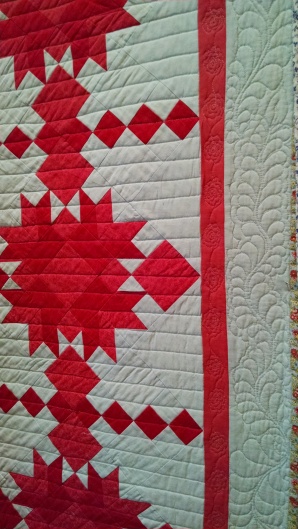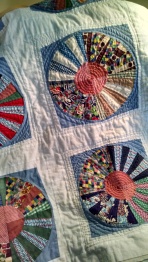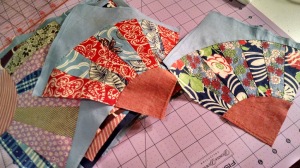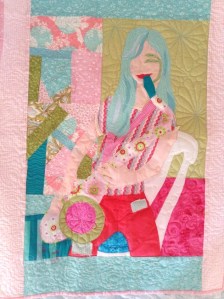Here in Mid-Michigan we experienced a relatively mild winter, but it has been very reluctant to leave. That meant a lot of days when quilting was a very appealing activity, and all the projects destined for the Midland Quilter’s Squared Quilt Show, held last weekend, were completed in time:
Below is the completed Mystery Quilt, composed of many more tiny squares than have ever crossed my table before for a project. Fortunately the errors aren’t too visible from here, and it makes me happy that my granddaughter, Isabella, is looking forward to receiving it.
This is a photo of another project I posted on earlier. The blue fan squares were part of a 1930-40 quilt top which was quite misshapen and had never been finished by its creator. The blocks were taken apart and reconstructed into flowers. White sashing and borders were then added and I spent the entire winter hand quilting it during the long evenings. The idea came from a presentation by Tim Latimer, but, unlike Tim, I am not very fast.

The last photo is a small wall hanging, done for this years quilt show challenge. We were to base our piece on a song. This one was inspired by “Swing on a Star” written for Bing Crosby. “Would you like to swing on a star…Carry moonbeams home in a jar…”

So, at last, gardening time is approaching and I have lots of smaller projects on the way. Happy May!



 usy most recently, is a “Mystery Quilt” project, organized by Midland Quilters Squared, to which I belong. Each month we were given a segment of the directions, until this month, when the final diagram was revealed. This has been a challenge for me, as piecing is not my favorite style and I am not given to perfectionism, so this has been a good stretching exercise for me. Somehow, it has resulted in a gallon sized baggie full of extra squares and triangles, so I obviously misunderstood a direction along the way. It was a happy day when it all came together this week. Here is a closer view that also gives a better ideas of the colors. (Pale sky blue and raspberries)
usy most recently, is a “Mystery Quilt” project, organized by Midland Quilters Squared, to which I belong. Each month we were given a segment of the directions, until this month, when the final diagram was revealed. This has been a challenge for me, as piecing is not my favorite style and I am not given to perfectionism, so this has been a good stretching exercise for me. Somehow, it has resulted in a gallon sized baggie full of extra squares and triangles, so I obviously misunderstood a direction along the way. It was a happy day when it all came together this week. Here is a closer view that also gives a better ideas of the colors. (Pale sky blue and raspberries)


























